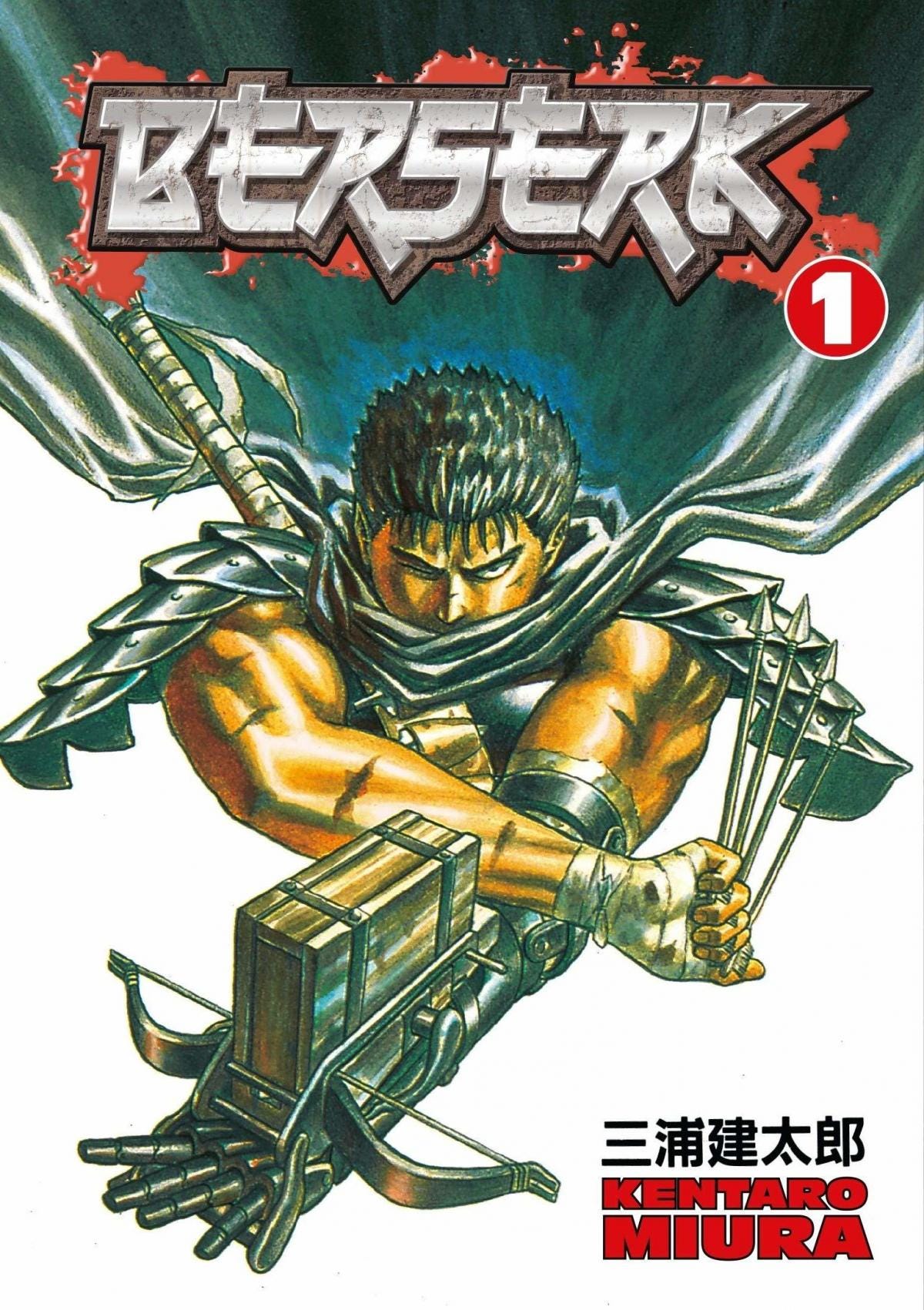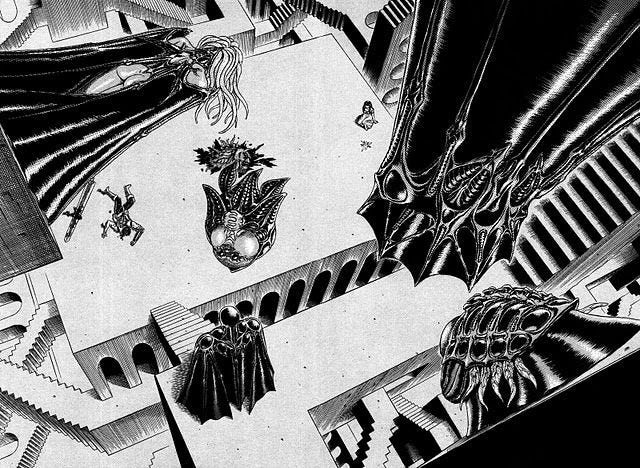GUTS.
A little bit, that single word would work as the entire review for the Black Swordsman Arc of Berserk, which comprises the first eight chapters of the manga. There are currently almost 400 chapters, so there’s a long way to go, but this serves as an interesting introduction to the world and its characters. Or at least its protagonist, Guts.
Which is the perfect name for this man. This Black Swordsman.
We enter the story without any setup or explanation or even any guidance. The first thing we see is Guts having sex with a woman who turns into a monster and tries to eat him.
Which certainly is a way to set the tone.
It’s a difficult narrative to really summarize, because it’s quite diffuse and sort of episodic. And it’s basically three main episodes at the start. The first one introduces Guts as the Black Swordsman. The second explains, in the briefest and vaguest way possible, why this is happening, and the third leads us towards a cataclysmic conflict.
Guts is a man with one eye, one metal arm, and a giant sword. A sword so big several characters ask if it’s just a big chunk of metal. This would go onto influence thousands of characters in the future, including mountains of anime and videogame characters and even the Knights Radiant of Brandon Sanderson’s Stormlight Archive.
We could stop and question how a man can wield a sword this large, but, I mean, we began this whole thing with him banging a monster so maybe hold your questions until someone feels open to answering.
Guts enters a town, causes some trouble, befriends an elf—who resembles a fairy more than an elf—and he draws the attention of the lord of this town who is also a huge monster. This monstrous lord demands sacrifices from his people. Human sacrifices. Women, children—doesn’t matter. He needs the flesh.
Guts fights and kills it with his gigantic sword after getting his ass kicked.
But along the way, little secrets are dropped at our feet.
What are we meant to make of this? First, we have this Eraserhead baby appearing out of nowhere. And in that same instant, our eyes taking in the whole page at once, we have Guts recognizing it.
If you haven’t raised an eyebrow yet, this is where that itch becomes unbearable.
There’s a whole life behind this moment that we know we don’t understand. Either we can carry on and hope explanation arrives or we can give up now.
In the second episode, where Guts fights a legion of skeletons and zombies, we discover that the brand scorched into his neck acts like a beacon for demons and monsters, which in this world are synonymous. This terrible brand bleeds when demons are near and causes Guts some amount of pain, alerting him to the fact that he’s in a demonic area.
Like a brutal Spidey-Sense.
His brand bleeds and he prepares for battle. A young girl is taken and turned by the demons while Guts is fighting a battalion of skeletons and the young girl, now a demon, stabs Guts. And so Guts does what he must and murders this demonic child.
This is the world of Berserk.
The world is overrun with demons. Many of the lords of the land appear to be demons themselves. Children are sacrificed to demons or become demons themselves.
No one is safe from evil and no evil is safe from Guts.
And in our third episode, we discover how a kind and righteous warrior can become a demon, but not until we’ve seen him at his worst.
We also discover, through repetition, that Guts essentially wanders the land seeking these demonic lords to kill.
Our demonic lord has a daughter who he has caged in her room ever since her mother died. This is also where the lord began to twist and turn away from the man he once was.
He’s a bad dude. He has heard of Guts and sets brutal traps to draw him out in order to kill him and sacrifice him.
Guts thirsts for this battle as well, but won’t be baited, and so he lets people die. Be executed.
Guts may be our protagonist but he is not a nice man. He may not even be a good man. He is, instead, driven.
By what, we’re not yet sure.
But Guts and this demonic lord do have their battle beneath his castle, with his monstrous demonic power nearly overwhelming Guts. Despite that, Guts manages to cut the demon’s head off while he lies gasping, broken.
And the demon begs for help, for life.
And then the Godhand shows up.
Four demons of such evil power that reality shifts around them, deforming, turning the castle into an Escher painting.
Guts recognizes one of them as well, so we know he’s experienced this before.
From the Godhand’s conversation, we learn that the brand is the mark of sacrifice and that Guts has fought against this destiny for a long time.
Thus and so, we lead into the climax of this Arc. We’re given a resolution that surprises in several interesting ways, but perhaps most interesting is the moral questions it forces upon you.
None of them are difficult, mind. But given the context and circumstances, we understand why the answers are not so clear cut for the characters involved. Even our demonic lord’s descent into evil makes sense, even if there were a thousand different ways it could have gone.
Despair. Fear. Pain.
We are sometimes broken by this trio.
What we see with Guts, though, is a man who was not broken. We’re not sure how despair and fear and pain have worked upon him, but we see a body ravaged by violence.
One eye.
One arm.
Countless scars.
A giant sword.
Who is Guts?
I want to linger on something that I believe is the most important piece in all this. This demonic lord who gives himself over to darkness, to the Godhand, does so to escape pain. To escape feeling sorrow and despair.
The Godhand swallows his pain, his emotion.
To become a demon is to give up pain.
And what do we see from Guts through these first eight chapter?
A man who feels pain almost all the time. A man bursting with rage, with disdain.
More than that, Guts seeks pain.
That’s my read on this, anyway.
Fighting demons is not easy. His body is nearly shattered by his fights with them. Even being near the demons causes him pain through his brand. Yet he persists.
His pain is what makes him human.
He refuses to give in, to be sacrificed, and instead chooses pain.
Humanity.
At this point, what we know most about him is that, even when broken and near death, he doesn’t give up. He embraces his pain and uses it to push him yet further.
And at the very end of this, we’re left with a new emotion from Guts. A single panel that may make you gasp to see it.
The first crack in his veneer.
And it comes right after he talks about the will required to live.
That is, perhaps, who he is: the will to survive.
To live.
The next Arc, The Golden Age, goes on for 10 volumes and brings us up to chapter 94. Since we just finished Chapter 8, expect this one to come…eventually.
Maybe April.
See you then.
My novels:
Glossolalia - A Le Guinian fantasy novel about an anarchic community dealing with a disaster
Sing, Behemoth, Sing - Deadwood meets Neon Genesis Evangelion
Howl - Vampire Hunter D meets The Book of the New Sun in this lofi cyberpunk/solarpunk monster hunting adventure
Colony Collapse - Star Trek meets Firefly in the opening episode of this space opera
The Blood Dancers - The standalone sequel to Colony Collapse.
Iron Wolf - Sequel to Howl.
Sleeping Giants - Standalone sequel to Colony Collapse and The Blood Dancers
Broken Katana - Sequel to Iron Wolf.
Libertatia; or, The Onion King - Standalone sequel to Colony Collapse, The Blood Dancers, and Sleeping Giants
Noir: A Love Story - An oral history of a doomed romance.
Some free books for your trouble:









Man, I need to keep reading this manga. I dug the first trade quite a bit.
This is a very odd anime, didn't it take inspiration from a Rutger Hauer movie? I recall reading up about that. Sorry for the ignorance on that topic, doubtless you know more than I on this one.